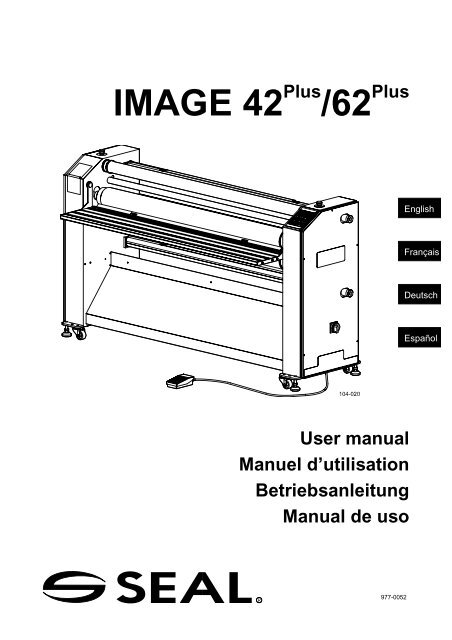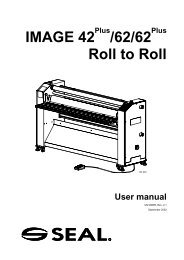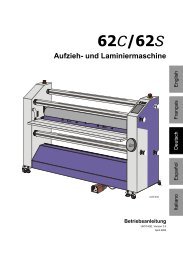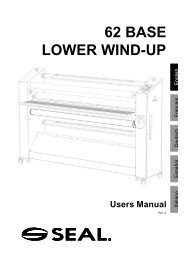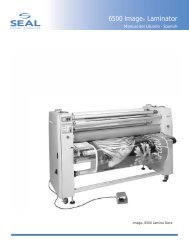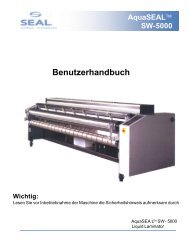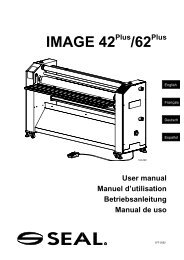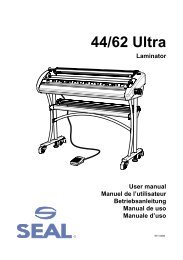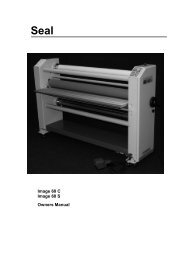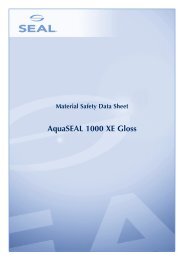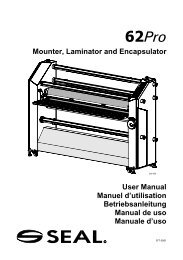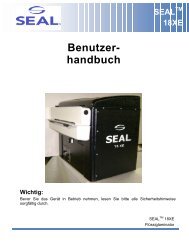IMAGE 42 /62 - SEAL Graphics
IMAGE 42 /62 - SEAL Graphics
IMAGE 42 /62 - SEAL Graphics
You also want an ePaper? Increase the reach of your titles
YUMPU automatically turns print PDFs into web optimized ePapers that Google loves.
<strong>IMAGE</strong> <strong>42</strong> Plus /<strong>62</strong> PlusEnglishFrançaisDeutschEspañolUser manualManuel d’utilisationBetriebsanleitungManual de uso977-0052
EnglishAll rights reservedAll information included in this manual as well as information included in supplements or addendum to this manual is subject tocopyright law. This information shall not be used, copied, reproduced, transmitted or disclosed to third parties without our prior writtenconsent.<strong>SEAL</strong> <strong>Graphics</strong> assumes no responsibility for any errors that may appear in this document nor does it make expressed or impliedwarranty of any kind with regard to this material, including, but not limited to, the implied warranties of merchantability and fitness for aparticular purpose.Seal <strong>Graphics</strong> shall not be liable for incidental or consequential damages in connection with, or arising out of the furnishing,performance, or use of this document and the program material which it describes.FrançaisTous droits réservés.Toutes les informations contenues dans ce manuel ainsi que celles des suppléments ou ajouts à ce manuel sont soumis aux lois sur lecopyright. Ces informations ne doivent pas être utilisées, copiées, reproduites, transmises ou divulguées à des tiers dans notreautorisation préalable par écrit.<strong>SEAL</strong> <strong>Graphics</strong> n'accepte aucune responsabilité pour toute erreur pouvant apparaître dans ce document et ne donne aucune garantietacite ou expresse eu égard à ce matériel, y compris mais sans s'y limiter, à toute garantie tacite de qualité marchande oud'adaptabilité à un usage particulier.<strong>SEAL</strong> <strong>Graphics</strong> n'est pas responsable des dommages accessoires ou indirectes liés à ou découlant de la diffusion, performance oul'utilisation de ce document et du matériel décrit.DeutschAlle Rechte vorbehalten.Alle Informationen in diesem Handbuch sowie Informationen in Ergänzungen oder Zusätzen zu diesem Handbuch unterliegen demUrheberrechtsgesetz. Die Informationen dürfen ohne unsere Genehmigung nicht verwendet, kopiert, wiedergegeben, übertragen oderan Dritte weitergegeben werden.<strong>SEAL</strong> <strong>Graphics</strong> haftet nicht für Fehler, die in diesem Dokument auftreten können, noch übernimmt <strong>SEAL</strong> <strong>Graphics</strong> Europe BV keinerleiausdrückliche oder implizite Garantie in Bezug auf dieses Material, einschließlich, jedoch nicht begrenzt auf die implizierte Garantie derMarktgängigkeit und Eignung für einen bestimmten Zweck.<strong>SEAL</strong> <strong>Graphics</strong> haftet nicht für auftretende oder Folgeschäden in Verbindung mit oder entstehend aus der Ausstattung, Leistung oderBenutzung dieses Dokuments und des Programmmaterials, das es beschreibt.EspañolReservados todos los derechos.Toda la información incluida en este manual y en los suplementos a anexos de este manual están sujetas a las leyes de derechos deautor. Queda prohibida la utilización, copia, reproducción, transmisión o divulgación de esta información a terceros sin nuestroconsentimiento previo por escrito.<strong>SEAL</strong> <strong>Graphics</strong> no se hace responsable de los errores que pudieran aparecer en este documento ni tampoco ofrece garantía implícitao explícita de ningún tipo en relación con el material descrito, incluyendo, aunque sin que ello constituya un límite, las garantíasimplícitas de comercialización e idoneidad para una finalidad concreta.<strong>SEAL</strong> <strong>Graphics</strong> no responderá de los daños imprevistos o emergentes relacionados con, o que puedan surgir del suministro,funcionamiento o el uso de este documento y del material de programa que describe.© 2000, 2002, Seal <strong>Graphics</strong>, the Netherlands.Seal <strong>Graphics</strong>P.O.Box 298100AA RaalteTel.: 0031 572 345 500Fax: 0031 572 345 501
<strong>IMAGE</strong> <strong>42</strong> Plus /<strong>62</strong> PlusEnglishUser manualUM104EN, Rev. 2.1September 2002
ContentsSubjectPageLimited Warranty on Seal Image Laminators .............................................. 2Contents ..................................................................................................... 3Illustrations.................................................................................................. 4Introduction ................................................................................................. 5Using this manual........................................................................................ 5Features and benefits of the Image <strong>42</strong> plus /<strong>62</strong> plus ......................................... 6Safety information ....................................................................................... 8Safety features............................................................................................ 9General information................................................................................... 11Technical specification .............................................................................. 13Identification.............................................................................................. 13Operating conditions ................................................................................. 13Uncrating and moving the Image <strong>42</strong> plus /<strong>62</strong> plus .......................................... 14Connecting to the electrical supply............................................................ 16General use .............................................................................................. 17Main switch ............................................................................................... 18Control panel............................................................................................. 19Emergency stop buttons ........................................................................... 23Loading rolls.............................................................................................. 23Webbing.................................................................................................... 24Unwind brakes .......................................................................................... 25Roller nip settings...................................................................................... 26Equivalent measurements......................................................................... 26Cooling fans.............................................................................................. 27Feeding images ........................................................................................ 27Laminating and Adhesive coating (Decaling) ............................................ 28Mounting ................................................................................................... 31Encapsulating ........................................................................................... 33Pre-coating................................................................................................ 36Temperature and speed settings............................................................... 37Cleaning and maintenance........................................................................ 38Troubleshooting ........................................................................................ 40Glossary of laminating terms..................................................................... 41Accessories............................................................................................... <strong>42</strong>Addresses................................................................................................. <strong>42</strong>En3
IllustrationsSubjectPageFeatures and benefits of the Image <strong>42</strong> plus /<strong>62</strong> plus ......................................... 6Working space .......................................................................................... 11Wood blocks ............................................................................................. 15Main switch ............................................................................................... 18Control panel............................................................................................. 19Emergency stop button ............................................................................. 23In-feed table.............................................................................................. 24Unwind brake ............................................................................................ 25Mounting / Dismounting image guide ........................................................ 27Decaling (with liner)................................................................................... 28Decaling (without liner).............................................................................. 28Webbing film (film + liner) ......................................................................... 29Placing the lower film across the roller faces............................................. 30Mounting decals ........................................................................................ 31Encapsulating............................................................................................ 33Placing the lower film across the roller faces............................................. 34Cutting off the leader................................................................................. 35Cleaning the upper roller ........................................................................... 38Cleaning the lower roller............................................................................ 394
IntroductionThank you for purchasing the <strong>IMAGE</strong> <strong>42</strong> plus /<strong>62</strong> plus laminator, a laminator designed to give youyears of reliable service. The <strong>IMAGE</strong> <strong>42</strong> plus /<strong>62</strong> plus brings a new level of simplicity and ease of useto image finishing.By following the guidelines outlined in this manual for proper care and maintenance, you candepend on receiving many years of trouble-free profitability from your investment.Reading this manual will familiarise you with the particular features, operational features andguidelines of your laminator.The manual includes instructions on various laminating techniques and diagrams that give you thecomprehensive information needed for safe, efficient use of your laminator. This basic knowledgeprovides the foundation for the creative, innovative uses you can build on, as you achieve thebasic skills through practice.The <strong>IMAGE</strong> <strong>42</strong> plus /<strong>62</strong> plus meets applicable EC Directives (89/392/EEC, including 91/368/EEC,93/44/EEC and 93/68/EEC) and is ETL listed (UL 1950/EN60950).EnUsing This ManualSpecial MarkingsWARNING: Please pay special attention to all passages markedthis way. This information is vital to the proper use andmaintenance of the laminator and to the safety of its users.☞Passagesmarked this way give information on theefficient use of the laminator.5
Features and Benefits of the Image <strong>42</strong> plus /<strong>62</strong> plusFeatures and benefits of the Image <strong>42</strong> plus /<strong>62</strong> plus6
Features and Benefits of the Image <strong>42</strong> plus /<strong>62</strong> plus1. Digital touch pad control-panel with LED indicators and preset settings for temperature,speed and substrate thickness.2. Swinging in-feed table for easy loading, with integrated Emergency Stop System.3. Image guard to help feed-in images and to prevent paper handling problems, and isremovable when mounting.4. High-release silicone rollers prevent adhesive build-up and make cleaning easy.5. Anti-static pull roller to help minimise static build-up.6. Automatic fan bank for efficient film cooling and smooth output during encapsulating.7. Pivoting, cantilevered supply shafts for easy loading and webbing. Both shafts are of theauto-grip design and are mounted on the rear of the machine.8. Side mounted unwind brakes allow easy adjustment of brake tension setting.9. Front take-up shaft for winding up the release liner off some laminates and adhesives.10. Identification plate detailing manufacturing information and CE mark.11. Quick reference guide gives information on recommended films, temperatures, speeds andwebbing.12. Emergency stop buttons.13. Mains switch.14. Foot switch.Also:Fast, electric heating and independent temperature controls with infra-red control formaximum accuracy.Sturdy, stand-alone design with fitted castors allow the machine to be easily moved andfeet levelled.Motor-driven, roller-height adjustment system for fast and accurate roller nip setting.En1RVKQPCN GSWKROGPV1RVKQPCNN[ GSWKROGPV EQORTKUKPI CP WPYKPFKPI CPF C YKPFKPI WPKV KU CXCKNCDNG6JKU CNNQYU [QW VQ YQTM NTQNN VQ TQNNO +H [QW TGSWKTG OQTG KPHQTOCVKQP QP VJKU OCVVGT RNGCUG EQPVCEV[QWT NQECN UWRRNKGT 6JKU QRVKQPCN GSWKROGPV KU FGUETKDGF KP VJG OCPWCN N+OCIG RNWU RNWUTQNN VQTQNNO7
Safety InformationThe <strong>IMAGE</strong> <strong>42</strong> plus /<strong>62</strong> plus laminator is provided with safety equipment to promote safe machineoperation. You should however take note of the following:Read and make sure you understand these safety and operating instructions.WARNINGS:Hot surfaces - Danger of getting injured by hot parts.Be careful with hot parts. The heated rollers can have a surface temperature ofup to 120°C (250°F). Do not touch the rollers. Even after the laminator has beenswitched off the rollers remain hot for a long time.Rotating parts - Danger of getting injured by rotating parts.The laminator is equipped with photoelectric eyes and protective plates andcovers to avoid contact with the rotating rollers. Make sure that these safetyprovisions are always in operation/fitted. Make sure that loose clothing, longhair, jewellery and fingers are not caught by the rotating rollers which mightresult in being trapped.The motor will stop automatically when the photo-electric eyes in front of themain rollers are interrupted.This does not happen when the foot switch is being used. in this case thelaminator will only work at 0.6 m/min (2′/min) and while the foot switch isbeing used an audible signal will be heard.Life electrical parts – Danger of getting injured electric shock.Do not remove the side panels of the <strong>IMAGE</strong> <strong>42</strong> plus /<strong>62</strong> plus laminator becausethere is a danger of getting injured by electricity. Only remove panels to domaintenance. In this case make sure the main electrical supply is off.Do not put heavy objects on the power supply cable.Danger of damage to equipment or injury to persons.This indicates the possibility of damage to equipment or injury to persons if thewrong tools or equipment are used.8
Safety Features• Photoelectric Safety Eyes - These self -checking eyesprevent foreign objects from passing in between the rollers. Theeyes are set for use at the factory and should not be adjustedexcept by a service representative.• Emergency Stop Buttons - There are two buttons and theyare located on the top of the left and right cabinets of themachine. They stop the rotation of the machine and should onlybe used in the case of an emergency.• Locking Cabinets - The cabinets which house the innerworkings of the laminator can be opened only with ascrewdriver.• Slow-Mode - The machine has a so-called slow-mode, whichcan be activated by pressing the foot switch. To maintain slowmode,keep the foot switch pressed.Once the machine is running in slow-mode, interrupting thephotoelectric eyes does NOT stop the machine; an audiblebeep will be heard, and the roller speed will be 0,6 m/min only.Releasing the foot switch will stop the machine.En• The rotation of the rollers will stop when:- the photoelectric eyes in front of the main rollers areinterrupted.NOTE: This does NOT happen when the foot switch isused (slow-mode).- an emergency stop button is pressed.- the foot switch is pressed for a short moment.- the input table is lifted.- excessive unwind tensions are set (the motor will be shut offelectronically, press the stop button on the control panel toreset).- the stop button on the control panel is pressed.- both 0,6 and 1,2 speed buttons are pressed simultaneously(to reverse the rotation direction of the rollers).9
Safety Features• If the machine is running then:- pressing an emergency stop button will immediately stop therotation of the rollers. After the emergency stop has beenreleased, the upper roller will move to its MAX opening.- lifting the in-feed table will immediately stop the rotation ofthe rollers. When the in-feed table has been swung back toits normal position, the upper roller will move to its MAXopening.- even tipping the in-feed table upwards (with your knee) willstop the rotation of the rollers, and lift the upper roller.• If the machine is NOT running then:- pressing the emergency stop buttons or lifting the in-feedtable will NOT result in lifting the upper roller.- if the upper roller is moving downward (during nip setting)then the upper roller will reverse its movement (goes to MAXopening) when the photoelectric eyes are interrupted at thatmoment.WARNING: Use of the inside of cabinets for storage may causepossible injury and/or damage to the inner workings and will void thewarranty.10
General InformationEnWorking SpaceR = RollL R = Roll length (115 cm for Image <strong>42</strong>, 160 cm for Image <strong>62</strong>)L B = Maximum board length11
General Information• Power Sources - Only connect the laminator to the powersupply specified on the identification label. Refer to the“Specifications” chapter of this manual for more information.• Water and Moisture - Install a RCD (GFI in U.S.A.) in thebuildings electrical supply if the laminator is to be used nearwater or in an area of high humidity.• Environment - Use your laminator in the cleanest, most dustfree environment possible to produce the highest quality output.The Image <strong>42</strong> plus /<strong>62</strong> plus consumes approximately 5,5 kW/8 kWof electricity. Because of the heat generated by the machine,the laminator should not be in the same room as anelectrostatic plotter, etc.• Working Space - The laminator requires a working area largeenough to allow the safe and efficient use. An area 4,5m x 6mwould be the smallest recommended. See previous page.• Rollers - NEVER cut or slice directly on any of the rollersurfaces as any resultant damage is not covered by thewarranty. ALWAYS use cutters with enclosed blades to preventcutting rollers and to avoid expensive replacement costs.• Do not feed objects such as staples, paper clips and rough orabrasive materials through the laminating rollers. Keep allobjects such as tools, rulers, pens, markers, etc. away from theroller opening. Refrain from leaving such items on the fronttable to prevent them accidentally being fed into the rollers.• The rubber covering of the top pull roller is very soft. Do notscratch its surface with a sharp object or a fingernail.• Servicing and Replacement Parts - Refer all servicing to yourdistributor. Servicing by any unauthorized technician voids thewarranty.WARNING: When the laminator is not in use, always ensure that thetop roller has been raised to prevent flat spots from developing. Flatspots will effect the quality of the output and is not covered by thewarranty.12
Technical Specification<strong>42</strong> plus <strong>62</strong> plusMaximum working width 1133 mm (44,5 in) 1615 mm (63.6 in)Maximum heated width 1110 mm (<strong>42</strong> in) 1575 mm (<strong>62</strong> in)Maximum speedMaximum main roller temperatureMaximum roller openingMaximum substrate thicknessRoller constructionShaft capacities (core inner diameter)Maximum material diameter1,8 m/min (6 ft/min)120°C (250°F)29 mm (1 1/8 in)25.4 mm (1 in)Steel with high-release silicone covering76.2 mm (3 in)210 mm (8 1/4 in)Dimensions Width 1720 mm (68 in) 2200 mm (87 in)HeightDepth1220 mm (47.3 in)7<strong>62</strong> mm (30 in) including tablesNet weight 440 kg (968 lbs) 523 kg (1153 lbs)Shipping weight 480 kg (1056 lbs) 573 kg (1263 lbs)Power supply - 3 phase*3N/PE 200-230 ±10% VAC50/60 Hz, 13 A3N/PE 200-230 ±10% VAC50/60 Hz, 16 APower supply - 1 phase (USA only)200-230 ±10% VAC50/60 Hz, 26 A200-230 ±10% VAC50/60 Hz, 35 AMaximum power consumption 5500 Watts 8000 W* Although 3 phase supply is used, it is not a true 3 phase machine. The three phases are used independently.EnThe information contained herein is general and does not constitute any warranties or guaranties.IdentificationThe machine has an identification plate. On the Image <strong>42</strong> plus /<strong>62</strong> plus it is located on the rear of theright cabinet.Operating ConditionsTemperature10°C ~ 50°C (50°F ~ 122°F)Do not expose the laminator to direct sunlight as output quality maybe affected.Moisture30% ~ 95% non-condensingIdeal humidity ~ 55%DustAvoid a dusty environment because the films used on this laminatormay attract dust and the output quality may be affected.13
Uncrating and Moving The Image <strong>42</strong> plus /<strong>62</strong> plusYour <strong>IMAGE</strong> <strong>42</strong> plus /<strong>62</strong> plus laminator is wrapped in plastic film to prevent moisture penetration. It iscrated on an integral 4-way entry pallet including a cardboard folding box.WARNING: When using a forklift, make sure that the length of the fork matches the size of thepallet. If necessary, use fork extensions.NOTE: If future transportation of the laminator is a possibility, the pallet, crate and securing boltsshould be kept in safe place.To uncrate the laminator, please follow the instructions below:Step 1 - Cut the straps that secure the cardboard box to the pallet.Step 2 - Remove the box, and, using the provided 19 mm openendedspanner, remove the four securing bolts, (located at thebottom of each cabinet) that hold the laminator to the pallet. Thenuse the provided 17 mm open-ended spanner to turn the fourmachine feet all the way down (clockwise direction) until the machinelifts a bit and the two wooden blocks can be removed. Next, turn thefour machine feet all the way up (turning anti-clockwise). Themachine is now standing on its four castors.Step 3 - Remove the two ramps provided, and place them on thefloor, against one of the short edges of the pallet.Step 4 - WARNING: This step should only be carried out by two ormore people. Do not attempt to do it on your own. Slowly roll thelaminator down the ramp and onto the floor. Carefully push thelaminator to its final location.Step 5 - Using a spirit level, adjust the feet so that the machine islevel from side to side (spirit level on front table) and front to back(spirit level on cabinet - check both sides).14
Uncrating and Moving The Image <strong>42</strong> plus /<strong>62</strong> plusStep 6 - Cut the plastic straps (1) securing the two wooden blocks (2)between the rollers. Refer to the applicable paragraphs and connectthe machine to the main electrical supply and set the main switch toON. The upper roller will raise automatically to the max position.Remove the wooden blocks from the rollers.EnWooden BlocksStep 7 - Refer to the applicable instructions and, with the heaters setto off, operate the machine to turn the rollers until the wedges,situated between the pull rollers, are released.15
Connection to the Electrical SupplyIn process of setting up your <strong>IMAGE</strong> <strong>42</strong> plus /<strong>62</strong> plus , the laminator will require connecting to theelectrical supply. This should only be carried out by a qualified person.NOTE:The machine is supplied with a 6 meter (20 feet) cable including a mains plug, inaccordance with the identification plate. If this cable has to be shortened, or if the plug hasto be changed, then the wire colors mean:In case of single phase operation (i.e. US):-Cable colorsUS colorsBlue - Neutral WhiteGreen/Yellow - Earth GreenBrown - Live BlackIn case of a three phase machine (i.e. Europe):-Blue -NeutralGreen/Yellow - Ground (Earth)Brown - Live phase 1Black - Live phase 2Black - Live phase 3Should you have any questions regarding the installation of your <strong>IMAGE</strong> <strong>42</strong> plus /<strong>62</strong> plus , pleasecontact your local Distributor.16
Main SwitchThe main ON/OFF switch is located on the right side of the machine.The switch has two positions:Supply voltage ON (I)Supply voltage OFF (O)The side cabinet, housing the electrical circuits, cannot be removed unless this switch is in theOFF position.Switch secured in OFF (O) positionThe switch can be secured in the OFF position to prevent unauthorized use.18
Control PanelThe laminator’s control panel is situated on the front right. The functions of the touch sensitivecontrol panel are divided into 4 sections as follows:-ROLLER NIP SETTINGThis section controls the vertical movement of the top main roller and also controls the nip settingwhen mounting onto substrates.NOTE: - Before switching off the machine, check that the upper roller is fully raised (MAXposition), to prevent a flat spot being induced into the rubber coating.9KVJCOOPKRQRGPKPI VJG VQR TQNNGT YKNN CWVQOCVKECNN[ OQXG VQ VJG OO QRGPKPIYJGP VJG OCEJKPG JCU PQV DGGP WUGF HQT OKPWVGU +H VJG PKR QRGPKPI KU OO QT OQTG CPF DQVJ JGCVGTU CTG UYKVEJGF QHH QT KH QPN[ VJG VQRJGCVGT KU UGV VQ u% VJG VQR TQNNGT YKNN CWVQOCVKECNN[ OQXG VQ VJG OO QRGPKPI YJGPVJG OCEJKPG JCU PQV DGGP WUGF HQT OKPWVGU +H VJG PKR QRGPKPI KU OO QT OQTG CPF KH JGCVGTU CTG UYKVEJGF QP GZEGRV HQT QPN[ VJGVQR JGCVGT UGV VQ u% VJG VQR TQNNGT YKNN CWVQOCVKECNN[ OQXG VQ VJG OO QRGPKPI YJGPVJG OCEJKPG JCU PQV DGGP WUGF HQT OKPWVGU +H VJG PKR QRGPKPI KU CNTGCF[ QT OO KP VJG CDQXG UKVWCVKQPU VJG VQR TQNNGT KU TCKUGFVQ VJG OCZKOWO QRGPKPI- The upper roller will move automatically from the MAX position to its previous setting ifthe foot switch or one of the three speed buttons is pressed. This will preventimages/boards from being fed in when the rollers are open.Pressing an up or down button will change the nip setting. Keep the button pressed until theflashing LED points to the desired value. When the upper roller reaches the actual setting, theLED will become steady. Any new setting will overwrite the previous internal setting.Pressing the up and down buttons simultaneously will cause the upper roller to open to MAX fromwhatever nip setting is currently selected.Pressing the two buttons again simultaneously will cause the roller to go back to its previoussetting.The up or down movement of the upper roller can be interrupted by any new nip setting, or bypressing the up and down buttons simultaneously.Important:- the nip setting can not be changed to a smaller value if a substrate is already placed betweenthe rollers (the nip setting mechanism can not ‘crush’ a substrate, and therefore it is not ableto find its new value). In this case, the upper roller will automatically move back to the MAXposition to make it possible to remove the substrate.- the nip setting system only functions if:- the machine is not running- the emergency stops are not activated- the infeed table is in its normal position- the machine can only run if a nip setting has been completed (when the according LEDbecomes steady).20
Control Panel- if the upper roller is moving downward (during a nip setting) then the upper roller will reverseits movement (goes to MAX opening) when the photoelectric eyes are interrupted at thatmoment.HEATER CONTROLThese sections control the temperature of the top and bottom rollers. Whilst warming the laminatorup, it is advisable to close the rollers and switch the motor on. From cold, the laminator takesapproximately 25 minutes to reach 120°C (250°F). The heaters maintain the selected temperatureto within ±4°C (±7.2°F) across the entire roll face.To prevent accidental changing of the heater settings, each button has to be pressed for 2seconds before the change takes place.During heating up, the relevant LED indicator will flash slowly. Once the temperature setting isreached the LED will become steady.Should an over-temperature situation occur, then the LED will flash at a fast rate.En☞6JGEQQNKPI HCPU YKNN QRGTCVG 10.; YJGP VJG VQR TQNNGT QT DQVVQO TQNNGT VGORGTCVWTGUGVVKPI KU u% u% QT u% +H [QW FQ PQV YCPV VJG EQQNKPI HCPU VQ QRGTCVG RTGUUVJG EJQUGP URGGF UGVVKPI DWVVQP CICKPIt is quite normal that, during and after the process, the temperature LEDs occasionally flash. Thetemperature controller will maintain the roller temperature within the temperature bandwidth.MOTOR CONTROLThis section controls the laminators motor speed. The figures quoted are liner speeds through therollers.Slow-modeThe machine has a so-called slow-mode, which can be activated by pressing the foot switch. Tomaintain slow-mode, keep the foot switch pressed.Once the machine is running in slow-mode, interrupting the photoelectric eyesdoes NOT stop the machine; an audible beep will be heard, and the roller speedwill be 0.6 m/min only. Releasing the foot switch will stop the machine.☞Changingfrom slow-mode to normal running mode without stopping (toprevent stop marks on the substrate):- during slow-mode (keep the foot switch pressed), press one of the preset speedbuttons, but do not release the foot switch yet- next, release the foot switch- finally release the speed button.21
Control Panel☞Changingfrom normal running mode to slow-mode without stopping:- press the foot switchNOTE: Releasing the foot switch will stop the machine.☞Reversingthe machineTo reverse the rotation direction of the rollers, press both 0.6 and 1.2 speed buttonssimultaneously. As long as the buttons are pressed, the machine will run in reversedirection, at a speed of 0.6 m/min only. Releasing the buttons will stop the machine.Care must be taken not to get loose clothing, long hair, jewellery and fingerspinched in the rear face of the pull rollers and main rollers.The rotation of the rollers will stop when:- The photoelectric eyes in front of the main rollers are interruptedNOTE: This does NOT happen when the foot switch is used (slow-mode).- An emergency stop button is pressed- The foot switch is pressed for a short moment- The input table is lifted- Excessive unwind tensions are set (the motor will be shut off electronically, pressthe stop button on the control panel to reset).- The stop button on the control panel is pressed- Both 0.6 and 1.2 speed buttons are pressed simultaneously (to reverse the rotationdirection of the rollers).22
Emergency Stop ButtonsThere are two buttons and they are located on the top of the left and right cabinets of the machine.They shut down the rotation and movement of the rollers and should only be used in the case ofan emergency. Once pressed these buttons lock, and they must be rotated to be reset before themachine can be used again. After being reset, the rollers will move to their upper position.See also Safety Information section.EnEmergency Stop buttonLoading RollsHow to load the laminator:Step 1 - From the rear of the laminator, load the required rolls ontothe top and bottom unwind positions ensuring that the rubberblocking cords are on the top and bottom of the shaft. Release theunwind tension if necessary, to turn the shaft to the correct position.☞NOTE:The adhesive side of the film should be facingyou.Step 2 - Centre the rolls in relation to each other by measuring fromcore of the roll to the side panel of the laminator. Both rolls shouldhave the same distance.WARNING:Do not overload the unwind shafts whileloading/unloading.23
WebbingSpecific webbing instructions for various applications are covered later in the manual, however,one of the most critical aspects to achieving good results is the process of webbing. Masteringwebbing is the key to operating the laminator effectively.During webbing, the in-feed table must be swung into the up position when webbing the lower film,and down when webbing the upper film.NOTE: If the in-feed table is swung up from the working position the drive motor will stop, (or notstart) until the table is repositioned.In-feed Table24
Unwind BrakesThe smooth flow of the laminating film is affected greatly by the unwind brakes. These are locatedon the right hand side of the machine.How to set the brakes:Turning the knob clockwise increases the film unwind tension; turningthe knob counter-clockwise decreases the tension.NOTE: In general, no or light unwind tension will be required.EnUnwind Brake25
Roller Nip SettingsWhenever you mount onto a board, etc., it is important to adjust the rollers to create a gap nearlyequal to the thickness of the board being used. This is done so that anything passing between therollers will receive the right amount of pressure and prevent damage to the rollers rubber surface(and possibly the board).How to set the nip:Step 1 - Determine the thickness of the board that you will use formounting.Step 2 - Adjust the nip setting by pressing either ▲▼ buttons on thecontrol panel to the same thickness as preciously measured.NOTE: For non-standard substrate thickness, select the next lowestnip setting i.e. 8 mm board - select 6 mm (1/4”) nip.☞NOTE:Pressing the up/down buttons at the same timeat any nip setting will send the top roller to the max.position. Pressing these buttons again will bring the toproller down to its previous set nip.Equivalent MeasurementsMetric (mm) Inches Decimal2 1/16 0.0<strong>62</strong>53 1/8 0.1255 3/16 0.18256 1/4 0.2510 3/8 0.37513 1/2 0.519 3/4 0.7525 1 1.00026
Cooling FansThe laminator is equipped with a bank of cooling fans that are used during encapsulation. Thefans are positioned at an angle to the web.☞The cooling fans will operate ONLY when the top roller or bottom roller temperaturesetting is 95°C, 110°C or 120°C. If you do not want the cooling fans to operate, pressthe chosen speed setting button again.Feeding ImagesTo aid feeding images, the laminator is equipped with an “Image Guide”. This device is bolted tothe feed-in table in front of the main rollers and it prevents the images from lifting away from thetable during feeding, or from interrupting the photoelectric eyes.EnHow to feed images:Mounting / Dismounting Image GuideStep 1 - For good results, the process requires that the images befed through correctly. The leading edge of each image must be flat allthe way across or any wrinkles or creases in the image will showwhen encapsulated - perhaps even magnified. To aid feeding, theleading edge should also be straight.Step 2 - Feed the image into the machine ensuring that the edge isparallel to the roller. To help this, the edge of the image can be seenthrough the two windows in the “image guide”, which is in front of therollers.NOTE: Do not stop the motor whilst an image is being finished as thiscan cause marks in the output.27
Laminating and Adhesive Coating (Decaling)This process involves sandwiching an image between either a hot or cold laminate on the face ofthe image and a pressure-sensitive adhesive on the rear. This process can be used to create selfadhesive images for mounting down onto various substrates.Once the machine reaches the operating temperature, the laminator may be stopped, the top rollerraised and webbed as per the following diagrams. Refer to the Temperature/Speed chart at theback of this manual for settings and recommended film combinations1. Heated top roller2. Heated bottom roller3 thru 5. Idlers6. Top pull roller7. Bottom pull roller8. Wind-up shaft9. Upper supply roll Lower supply roll.Decaling (with liner)1. Heated top roller2. Heated bottom roller3 thru 5. Idlers6. Top pull roller7. Bottom pull roller8. Wind-up shaft9. Upper supply roll10. Lower supply roll.Decaling (without liner)28
Laminating and Adhesive Coating (Decaling)Preparation:Select the films that you will use on the top and bottom of the images,it is advisable to use slightly wider width films compared to the printwidth. This way the print can be trimmed with a border, so as toreduce waste, but be enough to leave a border. Mount rolls onto theunwind shafts with the adhesive facing you. Web as follows:Step 1a - Linerless films - pull the film down from the top unwindstation and thread under the idler bar (unless pressure sensitive isused, then thread above idler). Pull the film evenly over the top rollerand across the face of the rollers.Step 1b - Linered films - pull the film down from the top unwindstation and thread under the idler bar. Connect the film and liner tothe take up station with a piece of tape. The take-up station shouldhave a scrap core placed over it to allow easy removal of the scrapliner. Split the film from the release liner and pull the film evenlyacross the face of the rollers.EnWebbing film (film + liner)Step 2 - Remove image guard and swing the table into the upperposition.☞NOTE: Check if the film widths of the upper and lowerweb are the same!NEVER use the pull rollers when decaling!29
Laminating and Adhesive Coating (Decaling)Placing the lower film across the roller faces.Step 3 - Pull the pressure-sensitive adhesive up from the bottomunwind station, across the face of the bottom roller, and place evenlyacross the top roller. The films will then heat and stick together.Step 4 - Lower the feed table into the operating position.Step 5 - Close the rollers, depress the foot switch and then using apiece of card as a leader, push the films into the nip of the rollers.Using the foot switch, advance the leader between the rollers until theend of it reaches the rear fan bank. Release the foot pedal.Step 6 - From the front of the laminator run the film and adjust thebrake tension on the unwind station until any wrinkles or creases inthe films over the face of the rollers are reduced to a minimum. Theyshould clear within approximately 1m (3-4 feet). If the wrinklespersist, cut the film and web the laminator again.Step 7 - Locate the image guard on the feed table.YOU ARE NOW READY TO FEED <strong>IMAGE</strong>S.30
MountingThis process involves mounting down previously made decals onto a substrate. No films oradhesives are used in this process.To mount decals onto a substrateStep 1 - Place the mounting board on a flat surface. Lay your imageface down on the mounting board and expose approximately 25 mm(1”) of the adhesive by peeling back the release paper along one ofthe edges. Fold the release paper back making an even crease.Step 2 - Turn the image over and carefully position the exposedadhesive edge of the image squarely onto the board.Step 3 - Once positioned correctly, press the image firmly down ontothe exposed adhesive from the centre toward the edges to ensuresmooth surface. This is the edge that will be fed into the rollers first.EnStep 4 - Ensure that the nip setting of the rollers corresponds to theboard thickness.Step 5 - Push the edge of the board into the rollers and depress thefoot switch until the board and image are just caught by the nip.Step 6 - Flip the in-tacked portion of the image over the top roller withone hand so that the release paper can be peeled off the image withthe other hand. Depress the foot switch to feed the board through therollers. At this point, continuous run can be selected by pressing oneof the speed settings.NOTE: Take care that the liner is not grabbed by the rollers.Mounting Decals31
MountingStep 7 - When the end of the board is near the nip, you may want toslow the machine down. To do this, just press the foot switch to enterslow mode. Releasing the foot switch will stop the machine.Step 8 - Remove the mounted image from the rear of the laminatorand trim it if necessary.If the board is accidentally sent in too far at first, the release liner willget caught and will be impossible to pull back. In this case, stop andreverse the motor until the liner can be pulled away. The image mustbe held against the roller while the board feeds through to preventwrinkles. As the process becomes more familiar, the speed of thelaminator may be increased to make the process more efficient.☞Takecare that the optical safety system is not tripped bythe release liner.NOTE: Only hard boards (PVC, Polystyrene, MDF, hard board, etc.)that are of the same thickness as the nip settings should be used,otherwise damage to the rollers can occur.32
EncapsulatingThis process involves completely sealing an image between two heat activated films.Once the machine reaches the operating temperature, the laminator may be stopped, the top rollerraised and webbed as per the following photographs and diagrams, Refer to theTemperature/Speed chart at the back of this manual for settings and recommended filmcombinations.1. Heated top roller2. Heated bottom roller3 thru 5. Idlers6. Top pull roller7. Bottom pull roller8. Wind-up shaft9. Upper supply roll10. Lower supply roll.EnEncapsulating☞Preparation:NOTE: Check if the film widths of the lower and upper web are thesame!It is advisable to use slightly wider films compared to the print width.This way the print can be trimmed with a border and not too muchfilm waste is generated, Mount rolls onto the unwind shafts withadhesive facing you. Web as follows:Step 1a - Linerless films - pull the film down from the top unwindstation and thread under the idler bar, (unless pressure-sensitiveadhesive is used, then thread above idler). Pull the film evenly overthe top roller and across the face of the rollers.33
EncapsulatingStep 1b - Linered films - pull the film down from the top unwindstation and thread under the idler bar. Connect the film and liner tothe take-up station with a piece of tape. The take-up station shouldhave a scrap core placed over it to allow easy removal of the scrapliner. Split the film from the release liner and pull the film evenlyacross the face of the rollers.Step 2 - Remove image guard and swing the table into the upperposition.Placing the lower film across the roller facesStep 3 - Pull the film up from the bottom unwind station, thread itaround the idler bar and up and over the face of the top and bottomlaminating rollers. The films will then heat and stick together.Step 4 - Lower the feed table into the operating position, and closethe rollers.☞NOTE: Keep the film under tension (turning the topunwind manually) to prevent the photoelectric eyes beingtripped when the upper roller is moving down.Step 5 - Depress the foot switch and then using a piece of card as aleader board, push the films into the nip of the rollers. Using the footswitch, advance the leader between the rollers until the end of itreaches the rear fan bank. Release the foot pedal.34
EncapsulatingNOTE: Use the 2 mm thick leader board supplied with the machine.Step 6 - Moving to the rear of the laminator, with the film/boardresting on the fan bank, cut off the leader leaving the film with astraight edge. Feed the film down into the pull rollers and use the footswitch to advance the film until it reaches about 15 cm (6”) beyondthe pull rollers and then stop the motor.EnCutting off the leaderStep 7 - From the front of the laminator run the film until the output iswrinkle free. Best results will be obtained when the film unwindtension is zero or very light.Wrinkles, visible on the roller face do not show on the output.Step 8 - Refit the image guard on the in-feed table.YOU ARE NOW READY TO FEED <strong>IMAGE</strong>S.35
Pre-CoatingThis process is used to coat substrates with a self adhesive coating onto which images can bemounted. The same process is used to create a carrier board (sled).Preparation:Mount the roll of self wound pressure sensitive adhesive on the topunwind of the laminator with the exposed adhesive facing you. Havea leader board ready with the same thickness as the boards to becoated.Step 1 - Pull the adhesive down from the top unwind station and overthe top roller evenly, and down across the face of both main rollers.Lift the in-feed table for a moment to do this.Step 2 - Measure the thickness of the board(s) to be coated, andselect the correct nip setting.Step 3 - Press the foot switch and, using the leader board, push theadhesive into the roller nip. Release the foot switch when the rearedge of the leader board is almost leaving the roller nip.Step 4 - Position the board to be coated into the nip, and choose oneof the three speed settings.☞NOTE:Do not wait for more than 5 minutes beforestarting the machine, otherwise the upper roller will raiseautomatically.When coating boards, ensure that the next board to be coatedfollows the previous board without any gaps.Step 5 - Follow the last board being coated with the leader boardonce again to allow the final board to clear the laminating rollers andthen stop the motor and raise the top roller.36
Temperature and Speed SettingsEn37
Cleaning & MaintenanceCleaningDo not use an abrasive cleaner on any surface. It may damage the surface ofthe silicone surface of the rollers or the paint work. Only use a damp cloth. Donot let water get onto the panels of the laminator as they are not sealed. Watermay enter the electrical circuits and cause injury to persons or damage to theequipment when power is applied.1. External SurfacesClean the external surfaces of the laminator with a damp cloth. If necessary, use householddetergent to remove difficult stains.2. CleaningUse an Image Roller Cleaner to remove excess adhesive. This should be done with therollers hot. When cleaning the top roller, place a scrap piece of board under the top roller toreduce waste adhesive falling onto bottom roller.Cleaning the Upper Roller38
Cleaning & MaintenanceEnCleaning the Lower RollerFor more thorough cleaning allow rollers to cool and then use isopropyl alcohol. This is bestdone using a clean, lint free cloth. Do not spill IsoPropylAlcohol (IPA) on the laminator.When using IPA, the rollers must be cold. IPA is inflammable. The flash point ofIPA (isopropanol) is 11°C (51.8°F). The self-ignition temperature is 400°C(752°F).NOTE: The rollers should be cleaned every day or the adhesive will build up and mayeventually damage the rollers.To clean the pull rollers use a clean, lint-free cloth moistened with water and householddetergent.MaintenanceThe Image <strong>42</strong> plus /<strong>62</strong> plus requires little maintenance, only the following are necessary:-1. Wipe the in-feed table with a dry cloth as necessary.2. Clean the rubber blocking cords on the unwind shafts as necessary.If a rubber blocking cord on the unwind shaft becomes too slack after a longer period oftime, unscrew one of the clamps, cut off 1 cm (0.5”) of the cord, and fasten it again using theclamp.For technical assistance, please contact your distributor.39
TroubleshootingProblem: The machine has no display• Solution 1: Unplug the machine. Check the fuses on the maincontrol board situated in the right cabinet. This should only bedone by authorized safety or maintenance personnel. Sparefuses are located on the upper horizontal cable channel.• Solution 2: Ensure that the mains supply to the laminator is O.K.Problem: The machine will not run.• Solution 1: Ensure that the emergency stop buttons have notbeen activated - rotate to reset.• Solution 2: Make sure the photo safety eyes are not blocked.• Solution 3: Make sure the in-feed table is in the down position.• Solution 4: With the laminator unplugged, check the fusesinside the right cabinet. This should only be done by authorizedsafety or maintenance personnel.Problem: The machine is not heating up.• Solution 1: Make sure that the heater(s) are switched on (LEDilluminated on control panel).• Solution 2: Check the circuit breaker for the machine. Thisshould only be done by authorized safety or maintenancepersonnel.Problem: The top roller is not descending• Solution 1: The in-feed table should be in the down position.• Solution 2: Release the emergency stops.• Solution 3: Something is tripping the safety eyes.Problem: The top roller is not ascending• Solution 1: Release the emergency stop.• Solution 2: The in-feed table should be in the down position.40
Glossary of Laminating TermsEncapsulating - Sandwiching an image between two heat activated films.Film - A synonym for laminate. The clear material used in the laminating and encapsulatingprocesses.In-feed - The side of the machine from which images are fed.Mounting - Affixing permanently an image onto some kind of backing board.Nip - The spot where the top and bottom rollers meet.Out-feed - The side of the laminator from which completed images emerge.Release Liner - The backing on a pressure-sensitive, heat-activated laminate or mountingadhesive. Once the release liner is peeled off, the adhesive layer becomes exposed.Decal - An image that has been laminated on top and has an adhesive backing.EnLeader Board - A piece of stiff card or foam board used to lead film, etc. into the nip of thelaminating rollers. Also used when pre-coating to prevent adhesive getting onto the rollers.Carrier Board (Sled) - A board that has a non-stick surface that is used when laminating one sideof an image only. These are sometimes made using a flat board coated with a self-wound.pressure-sensitive adhesive. The silicone release liner is not removed during coating and providesthe necessary non-stick surface).Pre-coating - The process of coating a substrate with an adhesive mounting film onto which animage can be mounted.41
AccessoriesThe following accessories are supplied with the machine:User manualQuick reference guideSafety knifeRubber cleaning blockTape measureSpare fuses (inside right-hand cabinet)Open-ended spanner set17 mm open-ended spanner10 mm Allen keyEmpty film coreLeader boardBoard-guide incl. fasteners.AddressesFor more information about <strong>SEAL</strong> <strong>Graphics</strong> products, contact please contact your nearest salesoffice.<strong>SEAL</strong> <strong>Graphics</strong> Americas7091 Troy Hill DriveElkridgeMD 21075U.S.A.Tel: (410) 379 5400Tel: (410) 379 8960<strong>SEAL</strong> <strong>Graphics</strong> Canada1601 Matheson Blvd. E. Unit # 4Mississauga, Ontario,CanadaL4W 1H9Tel: +1 905 212 9232 / 866 212 7325Fax: +1 905 212 9313<strong>SEAL</strong> <strong>Graphics</strong> UK Ltd1 Watkins Close,Burnt Mills Industrial EstateBasildon, Essex SS13 1BJUnited KingdomTel: +44 (0) 1268 530 331Fax: +44 (0) 1268 725 864<strong>SEAL</strong> <strong>Graphics</strong> Pacific LimitedUnit A, 13 th Floor, Block 1Leader Industrial CentreTsuen Wan, New Territories,Hong Kong.Tel: +852 2407 3738Fax: +852 2408 0973<strong>SEAL</strong> <strong>Graphics</strong> Europe BVKanaaldijk O.Z. 3P.O. Box 298100 AA RaalteThe NetherlandsTel: +31 (0) 572 345 500Fax: +31 (0) 572 345 501<strong>42</strong>


